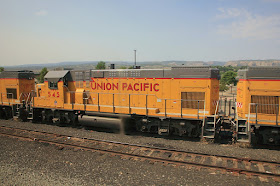So normally I would be super excited because the California Zephyr route between Green River, UT and Grand Junction, CO has probably some of the best scenery on the entire Amtrak LD network. However, this is my third time reporting on this route and unlike rail infrastructure, rock strata doesn't change much on human time scales. Furthermore, there was barely any rail traffic on this run so I am pretty much going to have to lean on the scenery photos. On the plus side the photos look better than before due to my new camera lens.
If you are wondering about the name of the set, all the way back in 2012 new signal hardware had been erected to replace the classic Denver, Rio Grand and Western kit and their associated pole line. The new signals had not yet been activated in 2014 and to my surprise they were still waiting to go into service in 2017! Therefore I had one last chance to document a pole line CTC route in service. You can check out the full set of photos here.
Like I said this segment starts at Green River, UT. Most of the line between Helper, UT and Green River had already been re-signaled so I used the opportunity to get some breakfast.
Like I said, the replacement signals had been standing in place for over 5 years. This example makes use of recycled US&S N-3 signal units, something else that went bay the wayside.
A westbound BNSF train was sitting on the FLOY siding, waiting to us for pass. Here we see C44-10W #7304 and on the rear was brand new ET44C4 #3913.
At Brendel UP ES44AC #8074, AC4400 #7927 and SD70ACe #8468 were on hand with a string of MoPac hopper cars at the Uranium tailings cleanup site.
The ELBA siding was being used to store a trail of coal hoppers.
At this point we start getting into the Ruby Canyon complex of the Colorado River. There are no roads into this canyon so the only ways to see it are by watercraft or by train.
The UTAHLINE siding is located on the border of Colorado and Utah. Apparently a marker was carved into the cliff wall, but I couldn't spot it.
Close up of the slide fence hardware at the boundary between sections. The springs provide some give if the fence is hit by small rocks, but large rocks will pull the plugs out and shunt the track circuit.
More Ruby Canyon scenery. The red/blue colored rock are iron bands.
This signal location is going to be relocated, but you can see how the pole line had to connect to every bit of signaling hardware.
The new signal mast will be placed just around the bend.
This is the famous money shot near the east end of the canyon where the banded rock strata can be seen being folded downward.
Seen again with the west end of the SHALE siding in the foreground.
The SHALE siding was also storing another cut of hoppers.
Non-stop scenery on this part of the run.
West end of the RUBY siding.
Short tunnel where the line cuts off a long bend in the Colorado River. The facing looks like it was made from local rock.
C&S crews making repairs at the west end of the MACK siding. After the old hardware is replaced, there will be no exposed wires needing constant repair and attention. Power will also be delivered via local utilities with any outages being their responsibility to fix.
Entering Grand Jct, I found a massive deadline where UP had decided to store most of their GP15-1 yard power. GP15-1's were light duty road switchers designed to replace older GP7/9 with something brand new in the same power class. With only a V12 instead of the GP38's V16, they saved on fuel during the age of oil embargos. Conrail and MoPac were the largest customers and today they are falling victim to Gensets and lower traffic volumes.
Also stored were a number of Control Car Remote Control Locomotive's. That's basically a fancy Union Pacific term for Road Slug. These were made from surplus B23-7 and B30-7 locomotives.
The deadline also had a few GMTX GP40-2's in it.
My Train 6 taking a smoke stop at Grand Junction, CO, with Amtrak P42DC's #172 and #124.
A pair of BNSF ES44C4's were hanging out at the east end of the Grand Junction platform. Here we see #8054 with an employee lining hand throw switches. The reason for all the BNSF traffic is due to a traffic rights agreement.
Here we can see BNSF #8340 backing up to couple to an oil train sitting along side the Grand Junction Amtrak station.
Well that's it for this week. Next time we finish up my 2017 Amtrak Trek with the slow slog to Denver.






























No comments:
Post a Comment